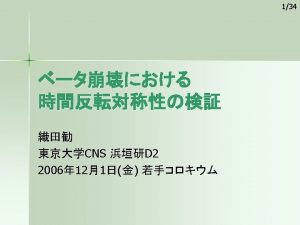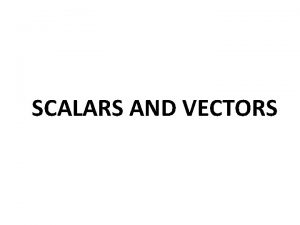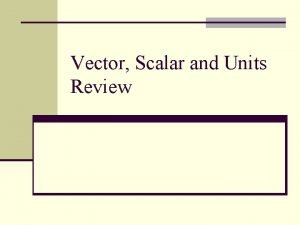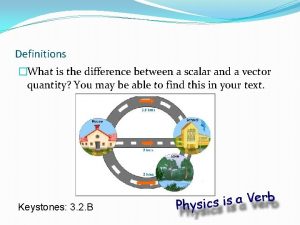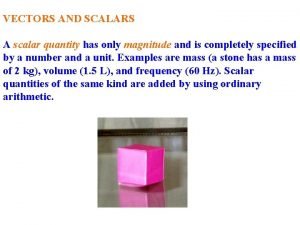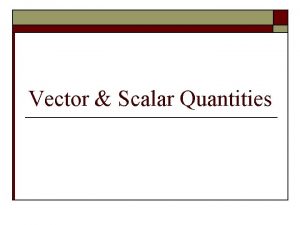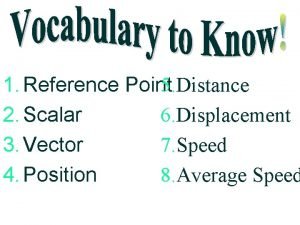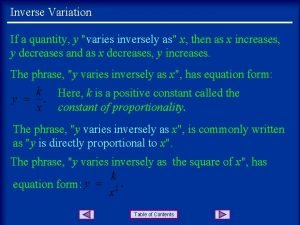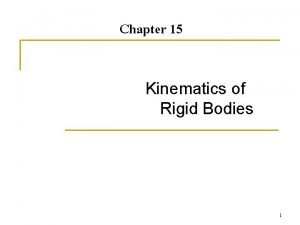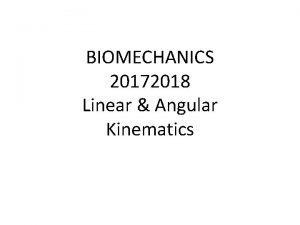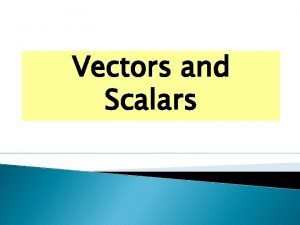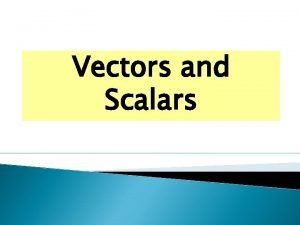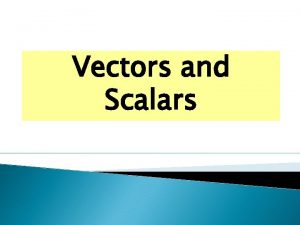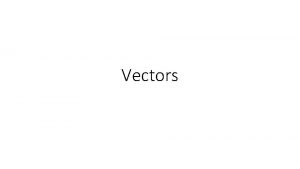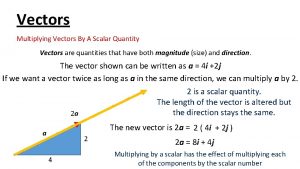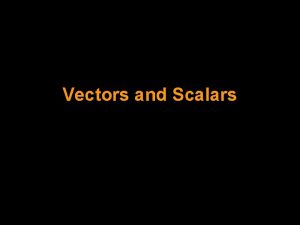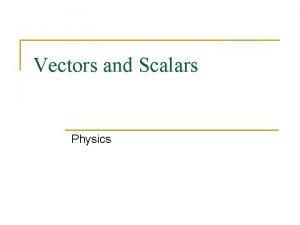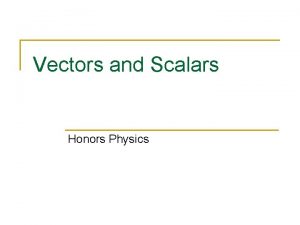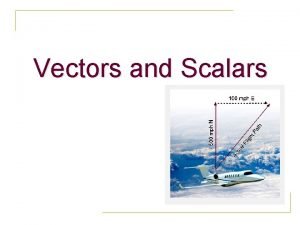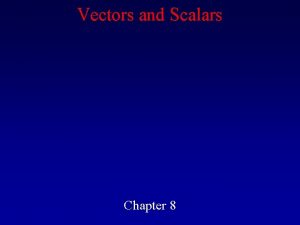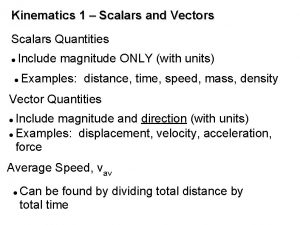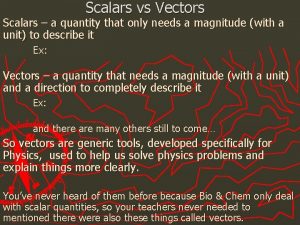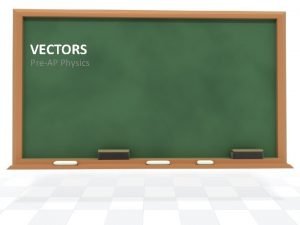Kinematics Vectors and Scalars Scalars A scalar quantity





















- Slides: 21

Kinematics Vectors and Scalars

Scalars �A scalar quantity is a quantity that has magnitude only and has no direction in space Examples of Scalar Quantities: � Length � Area � Volume � Time � Mass

Vectors �A vector quantity is a quantity that has both magnitude and a direction in space Examples of Vector Quantities: � Displacement � Velocity � Acceleration � Force

Vector � https: //youtu. be/b. OIe 0 DIMb. I 8

Vector Diagrams � Vector diagrams are shown using an arrow � The length of the arrow represents its magnitude � The direction of the arrow shows its direction

Resultant of Two Vectors � The resultant is the sum or the combined effect of two vector quantities Vectors in the same direction: 6 N 6 m 4 m 4 N = 10 m Vectors in opposite directions: 6 m/s 10 m/s = 4 m/s 6 N 10 N = 4 N

The Parallelogram Law � � � When two vectors are joined tail to tail Complete the parallelogram The resultant is found by drawing the diagonal The Triangle Law � � When two vectors are joined head to tail Draw the resultant vector by completing the triangle

Problem: Resultant of 2 Vectors Two forces are applied to a body, as shown. What is the magnitude and direction of the resultant force acting on the body? Solution: � � Complete the parallelogram (rectangle) The diagonal of the parallelogram ac represents the resultant force The magnitude of the resultant is found using Pythagoras’ Theorem on the triangle abc a 5 N � b � θ 12 N 13 12 d N 5 c Resultant displacement is 13 N 67º with the 5 N force

Problem: Resultant of 3 Vectors Find the magnitude (correct to two decimal places) and direction of the resultant of the three forces shown below. Solution: � Find the resultant of the two 5 N forces first (do right angles first) 5 � So, Resultant = 10 N – 7. 07 N = 2. 93 N in the direction of the 10 N force 7. 07 5 N a N 93 N 2. � Now find the resultant of the 10 N and 7. 07 N forces The 2 forces are in a straight line (45º + 135º = 180º) and in opposite directions 10 � N d 90º θ 45º 135º 5 N c 5 b

Recap � What is a scalar quantity? � Give 2 examples � What is a vector quantity? � Give 2 examples � How are vectors represented? � What is the resultant of 2 vector quantities? � What is the triangle law? � What is the parallelogram law?

Identifying Direction A common way of identifying direction is by reference to East, North, West, and South. (Locate points below. ) Length = 40 m N 40 m, 50 o N of E W 60 o 50 o 60 o E 40 m, 60 o N of W 40 m, 60 o W of S S 40 m, 60 o S of E

Identifying Direction Write the angles shown below by using references to east, south, west, north. N W 45 o E 50 o S 0 S of 50 Click to. Esee the Answers. . . W N E S 450 W of N

Vectors and Polar Coordinates Polar coordinates (R, q) are an excellent way to express vectors. Consider the vector 40 m, 500 N of E, for example. 90 o 180 o 270 o 90 o 40 m R 180 o 50 o 0 o R is the magnitude and q is the direction. 270 o q 0 o

Vectors and Polar Coordinates Polar coordinates (R, q) are given for each of four possible quadrants: 90 o q (R, ) = 40 m, 50 o 120 o 210 o 180 o 60 o 50 o 60 o 0 o q (R, ) = 40 m, 120 o q (R, ) = 40 m, 210 o 3000 270 o q (R, ) = 40 m, 300 o

Rectangular Coordinates y (-2, +3) (+3, +2) + (-1, -3) + x Reference is made to x and y axes, with + and - numbers to indicate position in space. Right, up = (+, +) Left, down = (-, -) (x, y) = (? , ? ) (+4, -3)

Trigonometry Review � Application Trigonometry y = R sin q R y of Trigonometry to Vectors x = R cos q q x R 2 = x 2 + y 2

Example 1: Find the height of a building if it casts a shadow 90 m long and the indicated angle is 30 o. The height h is opposite 300 and the known adjacent side is 90 m. h 300 h = (90 m) tan 30 o 90 m h = 57. 7 m

Example 2: A person walks 400 m in a direction of 30 o N of E. How far is the displacement east and how far north? N N R q x y 400 m E 30 o y=? x=? E The x-component (E) is ADJ: x = R cos q The y-component (N) is OPP: y = R sin q

Example 2 (Cont. ): A 400 -m walk in a direction of 30 o N of E. How far is the displacement east and how far north? N 400 m 30 o x=? Note: x is the side adjacent to angle 300 y=? E x = (400 m) cos 30 o = +346 m, E ADJ = HYP x Cos 300 x = R cos q The x-component is: Rx = +346 m

Example 2 (Cont. ): A 400 -m walk in a direction of 30 o N of E. How far is the displacement east and how far north? N 400 m 30 o x=? Note: y is the side opposite to angle 300 y=? E y = (400 m) sin 30 o = + 200 m, N OPP = HYP x Sin 300 y = R sin q The y-component is: Ry = +200 m

Example 2 (Cont. ): A 400 -m walk in a direction of 30 o N of E. How far is the displacement east and how far north? N 400 m 30 o Rx = Ry = +200 m E The x- and y- components are each + in the first quadrant +346 m Solution: The person is displaced 346 m east and 200 m north of the original position.
 Vector quantity and scalar quantity
Vector quantity and scalar quantity Scalar quantity and vector quantity
Scalar quantity and vector quantity Scalar quantities have size or magnitude only
Scalar quantities have size or magnitude only Polar and axial vector pdf
Polar and axial vector pdf Vectors and scalars in physics
Vectors and scalars in physics Vector in physics
Vector in physics Scalars and vectors
Scalars and vectors Vectors form 3
Vectors form 3 Multiplying or dividing vectors by scalars results in
Multiplying or dividing vectors by scalars results in Are newtons scalar or vector
Are newtons scalar or vector Aplusphysics kinematics-horizontal kinematics
Aplusphysics kinematics-horizontal kinematics Scalar and vector quantity difference
Scalar and vector quantity difference Scalar product of vectors
Scalar product of vectors Scalar quantity has only
Scalar quantity has only Scalar quantity characteristics
Scalar quantity characteristics Centripetal acceleration is scalar or vector
Centripetal acceleration is scalar or vector Is distance a scalar quantity
Is distance a scalar quantity Units physical quantities and measurements
Units physical quantities and measurements Y varies inversely as x example
Y varies inversely as x example Extension of scalars
Extension of scalars Kinematics and kinetics of rigid bodies
Kinematics and kinetics of rigid bodies Linear and angular kinematics
Linear and angular kinematics



